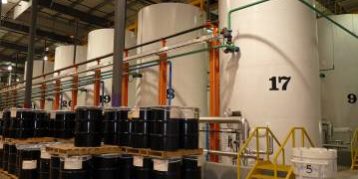ENEOS and JX Nippon Oil & Energy, producers of leading fully-synthetic, high performance motor oils and automotive lubricants, continues to advance the industry with research from our leading Research & Development (R&D) department. This R&D allows ENEOS to produce the highest-quality synthetic lubricants, provide increasing energy and environmental efficiencies, and tailor our products to the exacting specifications and tighter tolerances of Asian OEM (Original Equipment Manufacturers) vehicles, as well as continue as a leader in the lubricants field.

The ENEOS production plant in Alabama
Lube Report Asia has recently reported on one of ENEOS’ upcoming products, the lowest-weight 0W-16 viscosity oil to be introduced on the automotive market:
Despite initial skepticism of such lightweight grades, SAE 0W-16 oils will have a key role in the next PCMO (Passenger Car Motor Oil) standard from Japanese and American automakers and will be widely commercially available by 2018, an official from JX Nippon Oil & Energy said [last] month.
“We think it is necessary for lubricant manufacturers to continue to develop fuel economy technologies for combustion engines,” JX Nippon Oil & Energy Senior Manager Hiroya Miyamoto said on Dec. 4. The trend toward lighter-viscosity motor oils stems from the push to improve fuel economy and reduce emissions of greenhouse gases.
The article continues:
At the same time, automakers recognize that reducing oil viscosity also brings risks – mainly the potential for increased wear and higher levels of oil consumption. Therefore the industry has pushed lubricant suppliers to develop formulations that will contribute to fuel economy improvements without compromising engine protection. Miyamoto said JX Nippon Oil’s commitment can be seen in its purchase of sophisticated engine test stands and chassis dynamometers which allow vehicles to simulate prescribed driving conditions in a laboratory. “Only a few lube manufacturers in the world have this equipment,” Miyamoto said proudly.
Using those machines, the company was able to demonstrate that an SAE 0W-16 oil improves fuel economy up to 0.3 percent when the engine is hot and 2 percent when the engine is cold, compared to a 0W-20 product meeting API [American Petroleum Institute’s] SN/ILSAC GF-5 [latest performance standard].
This is a trend that will soon be sweeping the American auto industry:
Miyamoto said SAE 0W-16 oils are now a key element of the next North American PCMO specifications, which are currently being developed and due to be adopted in 2018. For the first time, the International Lubricant Standardization and Approval Committee will split its passenger car oil standard into two specifications, ILSAC GF-6A and GF-6B. The sole difference between them is that GF-6B will require a greater fuel economy contribution that can only be achieved with oils that are 0W-16 or lighter.
Miyamoto expects SAE 0W-16 oils will be widely commercially available when the new specifications take effect.
Meanwhile, Japanese automakers are continuing to push the market into lighter territory. Miyamoto said “super low” 0W-4 oils are now being studied in Japan, and he suggested they could be introduced to the market as soon as 2018.
“Japanese OEMs keep challenging [the engine oil industry] to lower viscosity,” he said. “We still have a gap between the fuel economy challenge and the technology of low- viscosity PCMO.”
ENEOS 0W-16 is anticipated for early release in the US and Canada by the end of 2016.
Keep watching our website and social media for future announcements about our latest developments, including our upcoming lower viscocity products! Industry developments can be found in the future in our News section under “ENEOS Perspective.”
The article “Japanese Race to Reduce Viscocity” published by Lubes N’ Greases: Lube Report Asia on 12/15/15, written by Tim Sullivan. Read the full article here.

